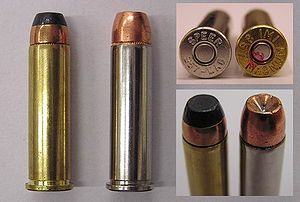.357 S&W Magnum
| .357 Magnum | ||||||||||||||||||||||||
|---|---|---|---|---|---|---|---|---|---|---|---|---|---|---|---|---|---|---|---|---|---|---|---|---|

.357 Magnum ammunition
|
||||||||||||||||||||||||
| Type | Handgun / Carbine | |||||||||||||||||||||||
| Place of origin | United States | |||||||||||||||||||||||
| Production history | ||||||||||||||||||||||||
| Designer | Elmer Keith, Phillip B. Sharpe | |||||||||||||||||||||||
| Designed |
1934 Introduced 1935 |
|||||||||||||||||||||||
| Specifications | ||||||||||||||||||||||||
| Parent case | .38 Special | |||||||||||||||||||||||
| Case type | Rimmed (R), straight | |||||||||||||||||||||||
| Bullet diameter | .357 in (9.1 mm) | |||||||||||||||||||||||
| Neck diameter | .379 in (9.6 mm) | |||||||||||||||||||||||
| Base diameter | .379 in (9.6 mm) | |||||||||||||||||||||||
| Rim diameter | .440 in (11.2 mm) | |||||||||||||||||||||||
| Rim thickness | .060 in (1.5 mm) | |||||||||||||||||||||||
| Case length | 1.29 in (33 mm) | |||||||||||||||||||||||
| Overall length | 1.59 in (40 mm) | |||||||||||||||||||||||
| Case capacity | 26.2 gr H2O (1.70 cm3) | |||||||||||||||||||||||
| Primer type | Medium revolver | |||||||||||||||||||||||
| Maximum pressure | 35,000 psi (241 MPa) | |||||||||||||||||||||||
| Ballistic performance | ||||||||||||||||||||||||
|
||||||||||||||||||||||||
|
Test barrel length: 4 in (102 mm) (vented) Source(s): Federal, DoubleTap Ammunition |
||||||||||||||||||||||||
1934
The .357 S&W Magnum (9×33mmR), or simply .357 Magnum, is a revolver cartridge with a .357-inch (9.07 mm) bullet diameter. It was created by Elmer Keith, Phillip B. Sharpe, and D. B. Wesson of firearms manufacturers Smith & Wesson and Winchester.
It is based upon Smith & Wesson's earlier .38 Special cartridge. The .357 Magnum cartridge was introduced in 1934, and its use has since become widespread. This cartridge started the "Magnum era" of handgun ammunition.
The .357 Magnum cartridge is notable for its highly effective terminal ballistics when used for hunting or defense.
The .357 Magnum was collaboratively developed over a period in the early to mid-1930s by a group of individuals in a direct response to Colt's .38 Super Automatic. At the time, the .38 Super was the only American pistol cartridge capable of defeating automobile cover and the early ballistic vests that were just beginning to emerge in the post-World War I "Gangster Era." Tests at the time revealed that those vests defeated any handgun bullet traveling less than about 1,000 feet per second (300 m/s). Colt's .38 Super Automatic just edged over that velocity and was able to penetrate car doors and vests that bootleggers and gangsters were employing as cover.
Though .38 and .357 would seem to be different diameter chamberings, they are in fact identical, as 0.357 inches (9.07 mm) is the true bullet diameter of the .38 Special cartridge. The .38 Special nomenclature relates to the previous use of heeled bullets (such as the .38 Short Colt), which were the same diameter as the case. Thus, the only external difference in the two cartridges is a slight difference in length, solely for safety purposes.
...
Wikipedia
